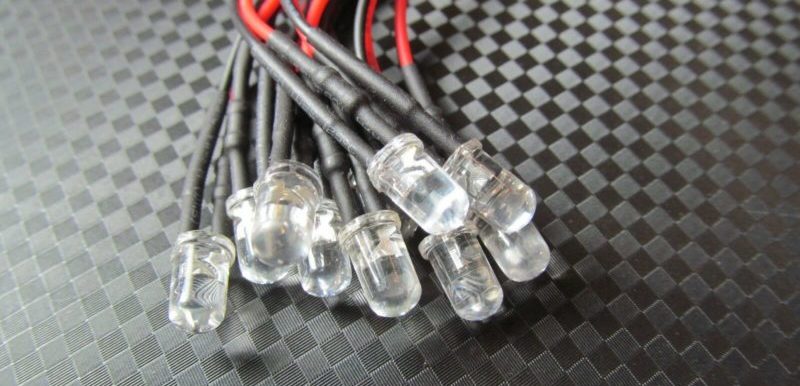Connecting an LED to 12 volts
An LED is a reliable element that will only work effectively if it is installed correctly. Switching a 12 volt LED should be done with particular care. Thus, there must be a current-limiting resistor, you must not forget about polarity, as well as the use of identical diodes in the same circuit.
What it is.
LEDs have long been popular lighting devices. This is due to their excellent energy efficiency and long life (compared to conventional bulbs). In addition, prices continue to fall as production of these products increases.
The main advantages are:
- durability - up to 10 years of continuous glow;
- durability - not afraid of shock and vibration;
- variety - a lot of sizes and colors of light;
- Low power consumption - it is 10 times more economical than an ordinary light bulb with similar characteristics;
- fire safety - due to low power consumption they do not overheat, so they are not capable of causing a fire.
LED (light emitting diode) is an abbreviation for light emitting diode. It is known from school physics course that it is polar. Therefore, the LED will not work if the polarity is not respected and it is likely to burn out (breakdown). The reverse breakdown voltage of a semiconductor structure is 4-5 volts. It can still work if it is connected correctly but it will become destructive and this will significantly reduce its lifetime.
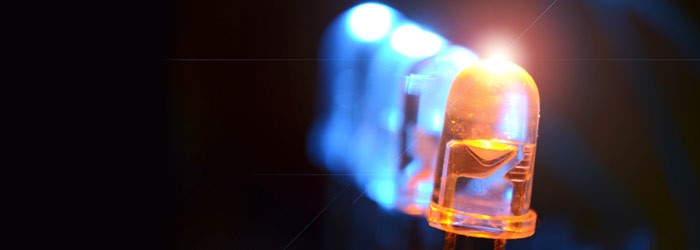
Simply put, a light-emitting diode (LED) is a semiconductor device that glows when an electric current passes through it. Because light is generated in a solid semiconductor material, LEDs are described as solid-state devices. The term "solid-state lighting" distinguishes this technology from other sources that use heated filaments (incandescent and tungsten-halogen) and discharge (fluorescent) lamps.
How to choose a LED to connect to 12 volts
The required type of diodes are selected on the basis of specific tasks. There are many options on the market, from indicator to heavy-duty. Low-power diodes can be used to illuminate the buttons and indicators on the dashboard in the car. Simple super-bright diodes are used for lighting the interior of the apartment or car. To install in the head optics, daytime head lights in cars or in flashlights are set high-power LEDs.
From a technical point of view, there are no restrictions on power and current consumption. The main thing is that the diode voltage does not exceed the voltage of the power supply.
An important factor is the size and shape of the housing. Depending on the application, round case diodes or SMD parts can be used. It all depends on the need and the application.
Which diodes can be connected to 12 volts
There is practically no voltage limit for LEDs. Therefore, almost any of them can be connected to 12 volts. The main thing is to follow the rules. LED bulbs usually need 1.5 to 3.5 volts, depending on color and brightness. If you see a 12 volt light-emitting diode on the store counter, you are actually being offered an assembly of several crystals connected in series.
Wiring options
It's a good time to familiarize yourself with the basic connection options.
To a single resistor

As we have already figured out above, the LED has polarity. Therefore, it is connected to a constant voltage power supply. The most common types consume about 10-20 mA. In fact - this is the main characteristic of the part. The second parameter is the voltage drop. For conventional LEDs it is in the range of 2-4 V.
The only correct wiring scheme is with a current limiting resistor. It is chosen according to Ohm's law. The resistor is calculated as the difference of the source voltage and the voltage drop divided by the product of the maximum current of the diode and the reliability factor (usually 0.75).
Ohm's law: "the amount of current in a circuit section is directly proportional to the voltage applied to that section and inversely proportional to its resistance."
It is also necessary to calculate the power of the resistor. It is calculated by a simple formula: the difference of the source voltage and the voltage drop squared divided by the resistance in ohms.
Connecting several LEDs in series
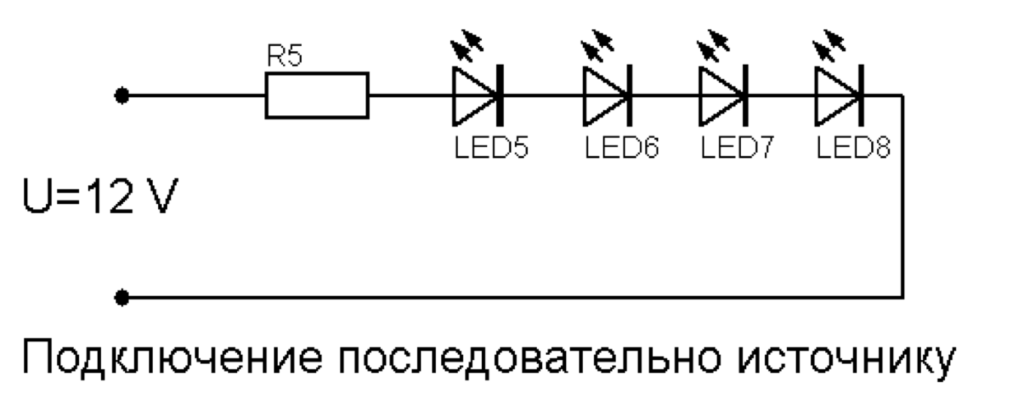
Wiring in series is the installation of two or more LEDs in one row. This circuit also uses a single current limiting resistor. The calculation formula is similar for a single diode, but the voltage drop is added up.
Let's take our theoretical white LED for 3 volts and 20 mA as an example. We connect three units in series. So the sum of our voltage drop will be 9 volts. We divide the remaining three volts by a current of 0.02 ampere with a reliability factor of 0.75. The result is that we will need one 200 ohm resistor.
Each diode to a separate resistor
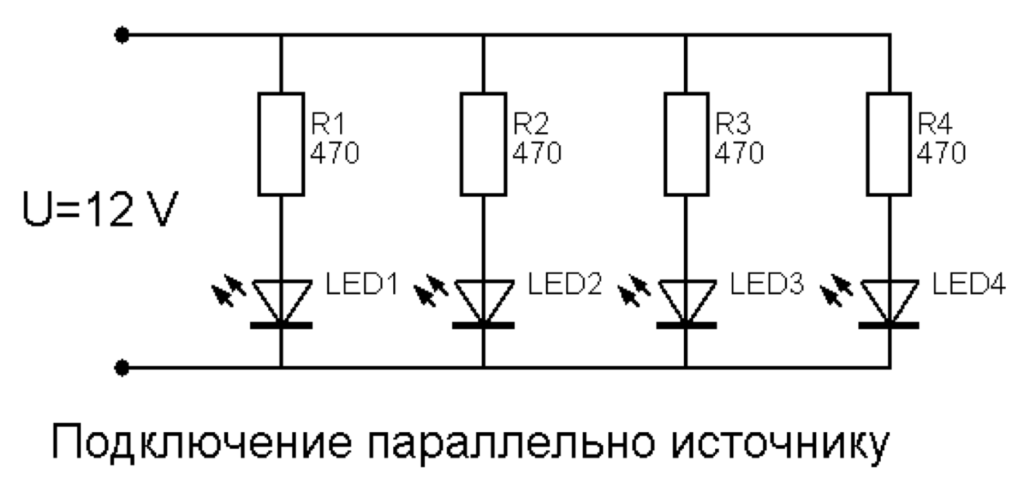
In this circuit each LED is connected to the plus and minus of the power supply. Although you can find schemes with one common resistor on the web, in practice this solution is not practical. Even in one batch the diodes differ in terms of current consumption and voltage drop. As a result, we get different intensity of glow of diodes. The resistance is calculated for each diode separately.
How to know the polarity of an LED
Looking at an ordinary round light-emitting diode, you will notice that its two leads have different lengths. This is how the cathode and anode are labeled. The anode is longer and is connected to the positive output of the battery or power supply and the cathode to the negative.
Also the cathode on some types of cases can be marked with a small saw cut. There are exceptions, so it is always a good idea to study the instructions for a particular diode.
How to connect to 12 volts
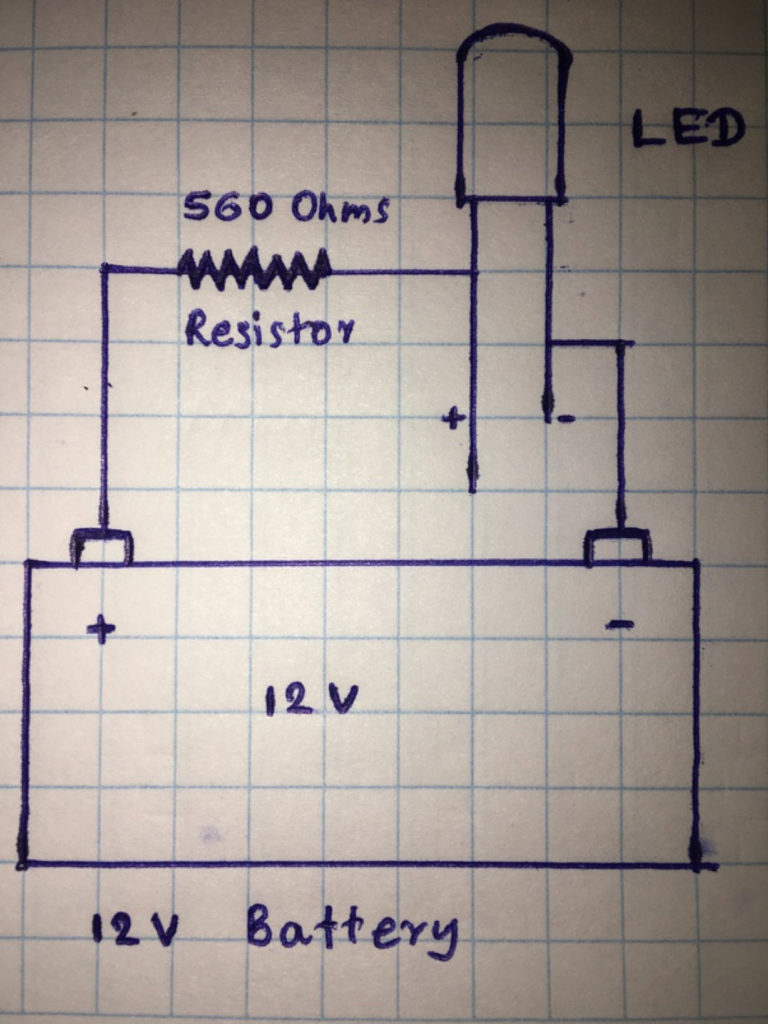
Diode connection diagram to a 12 V power supply does not differ from the standard one, but it is necessary to calculate the resistance and power of the resistor. To check or pre-test the assembly, one 1 kOhm resistor is enough.
For the example we will take the most common type of LED, a white LED with a maximum current of 20 mA. In fact, the voltages do not play a major role. The main thing is that the current should not exceed the maximum allowed parameters. The voltage drop is from 1.8 to 3.6 volts, depending on the model. For ease of calculation we will take 3 volts.
Resistance for LEDs

We calculate the parameters:
- The difference of the power supply voltage and voltage drop is 12-3=9.
- The product of the maximum current (amps) and the reliability factor - 0.02*0.75=0.015.
- Calculate the resistance (kOhm) - 9/0.015 = 600 (kOhm).

Calculation of resistor power:
- The difference in power supply voltage and voltage drop is 12-3=9.
- According to the formula, squared - 9*9=81.
- Divide by the resistance of the resistor in ohms - 81/600=0,135 W.
So a MRS25 resistor (0.6 W, 600 Ohm, ± 1%) would be perfect for us. For the middle of 2020 its cost is about 8 rubles. Usually it is not necessary to calculate the power of the resistor. Nevertheless, it is important to do this to test the future assembly.
Connecting high-power LED diodes to 12V
When connecting modern high-power crystals or their assemblies, the principle does not change. In the circuit must also be present a quenching resistor. For example, you can take a popular LED on Chinese marketplaces. This is an assembly of several crystals connected in parallel. The current consumption is 350 mA and the voltage is still 3.4 volts.
Substituting the parameters into our formula, we easily find out that we will need a resistor with a resistance of 32 ohms and a power of 2.2 W.
Efficient connection to one power supply
Above we have already found out that you can power an unlimited number of LEDs to one power supply. The main thing is that there is enough power. However, a simple parallel connection of the bulbs with a resistor for each of them is inefficient. From the previous point we saw that more than 2/3 of the power is dissipated by the current limiting resistor. Therefore the question often arises how many total LEDs can be connected to 12 volts.
The most efficient connection to 12 volts is considered a chain of three LEDs in series with a single resistor. The same scheme is used for all LED strips that operate from a 12 volt power supply.
Wiring problems

Circuit diagram for connecting LEDs:
- Do not use a current limiting resistor. Because too much current will flow through the LED, it will soon fail.
- Wiring in series without a resistor. Even if you think that plugging four 3-volt resistors into a 12-volt circuit is a good idea, you are mistaken. Because of poor current control, the elements will deteriorate quickly.
- Using the same resistor when the diodes are connected in parallel. Because of differences in characteristics, diodes will shine with different intensity. The fracture rate will increase.
We advise to watch a video on the subject: Proper connection of LEDs.
Conclusion
The reliability of LEDs is much higher than incandescent and gas-discharge models, but only when properly connected. Therefore, you can not forget about the need for a current-limiting resistor, which is selected according to a simple form. It is also mandatory to respect the polarity, especially when mounting the diode to a 12-volt circuit.
